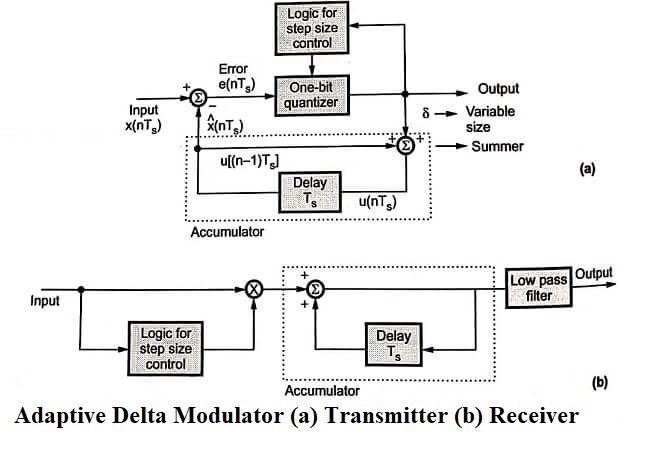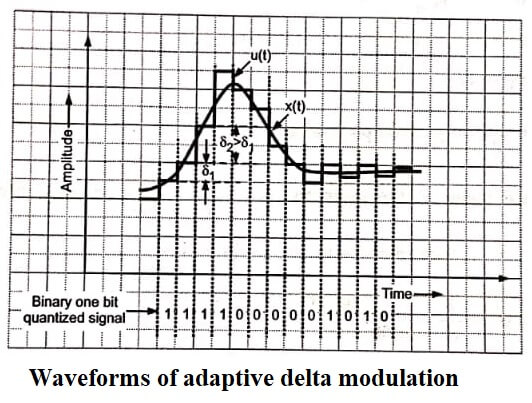To overcome the quantization errors due to slope overload and granular noise, the step size (δ) is made adaptive to variations in the input signal x(t). Particularly in the steep segment of the signal x(t), the step size is increased. When the input is varying slowly, the step size is reduced. Then the method is called Adaptive Delta Modulation (ADM).
The adaptive delta modulators can take continuous changes in step size or discrete changes in step size.
Fig (a) shows the transmitter and fig (b) shows receiver of adaptive delta modulator. The logic for step size control is added in the diagram.

The step size increases or decreases according to certain rule depending on one-bit quantizer output. For example if one-bit quantizer output is high (1), then step size may be doubled for next sample. If one-bit quantizer output is low, then step size may be reduced by one step. Fig shows the waveforms of adaptive delta modulator and sequence of bits transmitted.
In the receiver of adaptive delta modulator shown in Fig (b) the first part generates the step size from each incoming bit. Exactly the same process is followed as that in transmitter. The previous input and present input decides the step size. It is then given to an accumulator which builds up staircase waveform. The low-pass filter then smoothens out the staircase waveform to reconstruct the smooth signal.

Continuously variable slope delta modulation (CVSD)
In ADM, the step size changes in discrete steps. When the step size varies continuously, then it is called continuously variable slope delta modulation (CVSD).
Advantages of Adaptive Delta Modulation
Adaptive delta modulation has certain advantages over delta modulation.
- The signal to noise ratio is better than ordinary delta modulation because of the reduction in slope overload distortion and granular noise.
- Because of the variable step size, the dynamic range of ADM is wide.
- Utilization of bandwidth is better than delta modulation.
Plus other advantages of delta modulation are, only one bit per sample is required and simplicity of implementation of transmitter and receiver.
| Read More Topics |
| Automatic frequency correction |
| Superheterodyne receiver |
| Concepts of sampling theorem |
[sc_fs_faq html=”true” headline=”h2″ img=”” question=”What is the principle of ADM?” img_alt=”” css_class=””] In adaptive delta modulation, the step size is adjustable as per the slope of the input signal. Step size is made high if slope of the input signal is high. This avoids slope overload distortion. [/sc_fs_faq]





